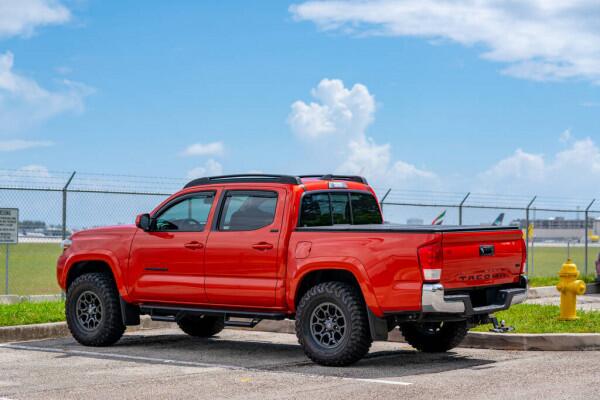Toyota Tacoma vs. Toyota 4Runner
Toyota Tacoma and Toyota 4Runner are two of the best vehicles for escaping the day and heading for the hills. They don’t compete directly—Tacoma is a pickup; 4Runner is an SUV—but both are midsize, tough, and adventure-ready. This guide highlights their key differences to help you choose.

Cabin Space
Tacoma: More spacious up front (head/hip/leg/shoulder room); seats up to five.
4Runner: Better second-row space and available third row; seats up to seven.
Bottom line: Need 6–7 seats and enclosed cargo? 4Runner. Mostly 1–4 passengers and bed utility? Tacoma.
Cargo & Towing
Tacoma: Open bed is ideal for large/long items; V6 tows up to 6,800 lb, 4-cyl up to 3,500 lb.
4Runner: Enclosed cargo (9 cu-ft behind 3rd row; 46.3 cu-ft with 3rd row down; 89.7 cu-ft max with 2nd row down); tows up to 5,000 lb.
Technology & Features
Tacoma: 7" (SR) or 8" touchscreen; Android Auto/Apple CarPlay/Amazon Alexa; 4–6 speakers (JBL on Limited/TRD Pro).
4Runner: 8" touchscreen across trims; more speakers available and up to 15-speaker JBL on higher trims.
Powertrain
Tacoma: 2.7L I-4 (159 hp/180 lb-ft) or 3.5L V6 (278 hp/265 lb-ft); 6-speed auto, available 6-speed manual (TRD 4x4); RWD or 4x4.
4Runner: 4.0L V6 (270 hp/278 lb-ft); 5-speed auto; RWD or 4x4 depending on trim.
Takeaway: Tacoma offers more transmission/drive choices and better acceleration/tow ratings when comparably equipped.
Fuel Economy
Tacoma (approx.): Up to 20/23 mpg (2WD I-4); 19/24 mpg (2WD V6); 18/22 mpg (4x4 V6); manual TRD ~17/21 mpg.
4Runner: ~16/19 mpg (most trims).
Winner: Tacoma.
Safety
Both include Toyota Star Safety System and Toyota Safety Sense (PCS w/ Pedestrian Detection, LDA, AHB, DRCC). 4Runner adds more airbags across three rows.
Styling
Both lean rugged; TRD trims are bolder, Limited trims upscale. 4Runner sits taller/wider; Tacoma has a larger grille and sportier stance.
Pricing (sample new MSRPs when last compared)
Tacoma: From $27,345 (SR Access Cab). Double Cab SR from $28,175 (I-4) / $33,610 (V6); TRD Off-Road V6 4x4 from ~$38,475; Limited V6 4x4 from ~$43,175.
4Runner: SR5 RWD from ~$36,440; 4x4 from ~$39,815; TRD Off-Road 4x4 from ~$41,905; Limited 4x4 from ~$48,880.
See used Toyota Tacoma pricing | See used Toyota 4Runner pricing
Conclusion
Pick Tacoma if you want a bed, higher tow ratings, better fuel economy, available manual transmission, and lower entry price. Choose 4Runner if you need 3 rows, maximum enclosed cargo, more onboard speakers, and SUV practicality.
Helpful Links
Sources
Cole, A. (2020-01-30). 2020 Toyota Tacoma vs. 2020 Toyota 4Runner — The Car Connection
O’Neill, C. (2020-07-06). What’s the Difference? — Autotrader
Rall, P. (2021-05-10). Which Mid-Sizer Is Right for You? — AutoGuide